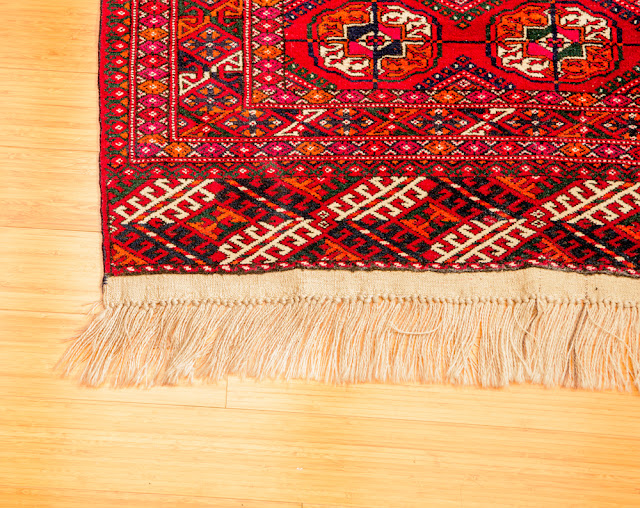How do you know if a rug is handmade?
Since handmade area rugs will in
general be more costly than their machine-made counterparts, you'll need to
know whether your new rug is authentic or not. In this blog, we'll present some
essential terms with regard to high-quality area rug construction. On the
other hand, we will also present how to reveal the quality and get it separated from
machine-made rugs.
Hand-knotted rugs vs. hand-tufted rugs
All "true" Oriental
rugs are hand-knotted. In this complicated
and labor-intensive process, the warp is extended vertically over a wooden
loom. Line-by-line, the craftsman will exclusively knot the pile onto the warp,
weave in the weft, and firmly pack the yarns along with a substantial comb.
Through this process, the weavers cause the establishment of the area rug
as they go, and the pile turns into a significant aspect of the rug's general
construction. The outcome is an amazingly durable, yet still delicate and
flexible work of art.
By contrast, hand-tufted area
rugs start with a solid foundation generally made of jute or cotton
canvas. Artisans then
punch the pile of the area rug through this establishment using an air-fueled "tufting gun". Usually while
following an example that has been followed or printed onto the material. The
pile is then sheared and held set up with a stick and a support material like
latex. This process requires considerably less expertise than hand-knotting, so
hand-tufted area rugs can be made more rapidly.
How to Tell Your Handmade Rug is Authentic
Since you know a little more about how hand-knotted rugs
are made, we should delve further into how they differ from machine-made rugs
and how to distinguish the two.
Check the back
The most effortless way to tell whether you have a
real hand-knotted area rug is to check the back. As expressed over, the pile of
hand-knotted floor rugs is tied legitimately into the warp. While machine-made
rugs will be pushed through and held set up with glue and an extra backing
material like what's found close by tufted rugs. The rear of a hand-knotted rug
should be delicate and flexible, with unmistakably visible knots in an example
that reflects the front of the area rug. If few of those knots seem looser than
others, that is a decent sign! Even the most skilled artisans won't be equipped
for machine-like exactness. So, some unevenness is a pointer that your rug is
handmade.
Check the dye
Genuine Oriental and Persian area rugs are made
with natural vegetable colors that throughout the hundreds of years have been
found to not run. Checking if the color is colorfast is a sure-fire way to tell
if your area rug is authentic. A simple method to check is to leave a damp
cloth on it overnight. If any color moves to the cloth, it isn't colorfast and
risks running should you ever spill liquid on it in the future?
Check the fringe
In a real hand-knotted rug, the fringe is produced
using the overabundance warp yarns on either end of the rug after it has been
removed from the loom. Machine-made rugs will regularly imitate this look with
a fringe that is either glued or sewn on afterward. If your rug has a sewn-on
fringe, it isn't valid—the fringe hand-knotted rugs are consistently basic.
Check the material
True Persian and Oriental area rugs are constantly
made with 100% natural fibers. Usually, this implies a cotton foundation and
pile produced using wool, silk, or a mix of the two. If your area rug
contains any synthetic materials like polyester or polypropylene(This should not be
mistaken by Hand Tufted Shags which are made by polyester yarns), it can't be known as a
veritable Oriental area rug.
Check the price
While this won't be as reliable as checking how the
rug is fabricated, you should in any case consider the cost while looking for a
hand-knotted area rug. This is particularly significant when buying online.
For many people, hand-knotted rugs are investment
pieces and family legacies. While we won't express it's difficult to get a good
deal, you should expect to spend somewhat more on handmade rugs. Making a
hand-knotted rug is a troublesome and
time-intensive process. It may take a group of skilled and expert weavers a
year or more to finish a room-sized rug. Accepting they are working full-time.
Price tags of a few thousand dollars are defended while considering the expense
of premium materials. In the case of Persian Rugs, the cost increment that
accompanies their scarcity. If a room-sized area rug presenting itself as a
genuine Persian or Oriental carpet for just a couple hundred dollars, there is
a generally excellent possibility it is a fake.
Buying a Handmade Rug Online
If you decide to purchase a handmade rug online,
pay close attention to the reputation of the website. Take your time, check
reviews and testimonials, and search for purchaser assurance services and
return policies. If you have any inquiries or need the extra confirmation of
certification of authenticity. Don't be hesitant to call customer support! A
trustworthy vendor will be more than willing to work with you.
At getmyrugs.com, we
make sure to check all the boxes, so our clients feel positive about online
rugs buying process. With many years of experience working with handmade and
machine-made rugs, we endeavor to enable each client to find the ideal area rug
for each room of their home.






Comments
Post a Comment